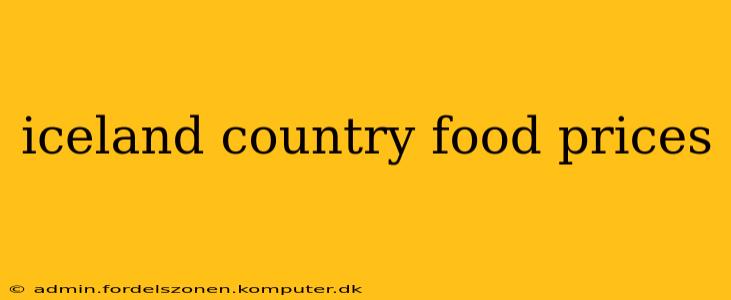Iceland, a land of fire and ice, boasts stunning landscapes and a unique culture. But for travelers, one of the biggest concerns is the cost of living, particularly food prices. This guide will delve into the realities of Iceland's food costs, helping you budget effectively for your trip. We'll explore everything from groceries to restaurant meals, offering insights and tips to navigate the Icelandic culinary scene without breaking the bank.
How Expensive is Food in Iceland?
Iceland consistently ranks as one of the most expensive countries globally, and food is no exception. Expect to pay significantly more than you would in many other European countries or North America. The high cost is driven by several factors, including Iceland's remote location, reliance on imports, and strong currency. However, with smart planning and some savvy choices, you can manage your food budget effectively.
What are the Average Prices of Groceries in Iceland?
Grocery prices in Iceland vary depending on the store and the product. Generally, expect to pay a premium compared to other countries. Here’s a rough estimate of average prices (as of late 2023; prices fluctuate):
- Milk (1 liter): $3-$5
- Bread (loaf): $4-$6
- Eggs (dozen): $5-$8
- Cheese (100g): $3-$5
- Meat (per kg): $20-$40 (significantly more expensive than in many other countries)
- Fruits and Vegetables: These are often the most expensive items, and locally grown produce is usually more affordable than imported options.
Tip: Consider shopping at Bonus or Krónan, which are generally considered the more budget-friendly supermarket chains in Iceland.
How Much Does Eating Out in Iceland Cost?
Dining out in Iceland can be a significant expense. Costs vary greatly depending on the type of restaurant and the location.
- Fast Food: A simple fast-food meal might cost around $15-$25.
- Mid-Range Restaurants: Expect to pay $30-$50 per person for a main course and drinks.
- Fine Dining: Fine dining experiences can easily cost $100 or more per person.
Tip: Look for lunch specials, which are often more affordable than dinner menus. Also, consider exploring smaller, less touristy restaurants for potentially lower prices and a more authentic Icelandic experience.
What are Some Budget-Friendly Food Options in Iceland?
While Iceland is expensive, you can still find ways to keep your food costs down. Here are some suggestions:
- Self-Catering: Staying in accommodations with kitchen facilities allows you to prepare some of your own meals, significantly reducing your food expenses.
- Grocery Shopping: Stock up on essentials at supermarkets like Bonus or Krónan.
- Local Markets: Check for local farmers' markets, where you might find fresher and potentially more affordable produce.
- Street Food: While not always the cheapest option, street food can offer a more budget-friendly alternative to sit-down restaurants.
- Pack Snacks: Bring some snacks from home, especially if you plan on hiking or exploring outdoors.
Are there any cheaper alternatives to eating out every day?
Yes, absolutely! As mentioned above, self-catering is the most significant way to cut costs. Preparing breakfasts and lunches in your accommodation can save you considerable money. Even simple sandwiches or salads can be far cheaper than eating out. Also, consider picnics! Iceland's breathtaking landscapes provide the perfect setting for a picnic lunch.
What are the typical Icelandic dishes and how much do they cost?
Icelandic cuisine features hearty dishes often made with locally sourced ingredients (when possible). Plátur (lamb dishes), fish stews, and Skyr (a type of yogurt) are common favorites. The prices for these dishes vary depending on the restaurant, but expect to pay similar prices to other main courses in Iceland’s restaurants.
What about Alcohol prices in Iceland?
Alcohol is also expensive in Iceland due to high taxes and a government-controlled system. Expect to pay significantly more than in other Western countries. If you're planning on drinking, budgeting for this is essential.
Conclusion: Planning for Food Costs in Iceland
Food in Iceland is undoubtedly expensive, but with careful planning and budgeting, you can still enjoy delicious food and manage your expenses effectively. Prioritize self-catering where possible, explore more budget-friendly dining options, and remember to factor in food costs when planning your Iceland adventure. By making informed choices, you can savor the Icelandic culinary scene without emptying your wallet.
